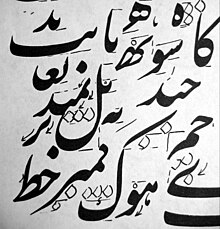
A | B | C | D | E | F | G | H | CH | I | J | K | L | M | N | O | P | Q | R | S | T | U | V | W | X | Y | Z | 0 | 1 | 2 | 3 | 4 | 5 | 6 | 7 | 8 | 9
This article has multiple issues. Please help improve it or discuss these issues on the talk page. (Learn how and when to remove these template messages)
|
| Persian alphabet الفبای فارسی Alefbâye Fârsi | |
|---|---|
 | |
| Script type | Abjad
|
| Direction | Right-to-left script |
| Languages | Persian |
| Related scripts | |
Parent systems | |
| Persian alphabet |
|---|
| ا ب پ ت ث ج چ ح خ د ذ ر ز ژ س ش ص ض ط ظ ع غ ف ق ک گ ل م ن و ه ی |
|
Perso-Arabic script |
The Persian alphabet (Persian: الفبای فارسی, romanized: Alefbâye Fârsi), also known as the Perso-Arabic script, is the right-to-left alphabet used for the Persian language. It is a variation of the Arabic alphabet with five additional letters: پ چ ژ گ, in addition the obsolete ڤ.[1]
It was the basis of many Arabic-based scripts used in Central and South Asia. It is used for the Iranian and Dari standard varieties of Persian; and is one of two official writing systems for the Persian language, alongside the Cyrillic-based Tajik alphabet.
The script is mostly but not exclusively right-to-left; mathematical expressions, numeric dates and numbers bearing units are embedded from left to right. The script is cursive, meaning most letters in a word connect to each other; when they are typed, contemporary word processors automatically join adjacent letter forms.
History
The Persian alphabet is directly derived and developed from the Arabic alphabet. The Arabic alphabet was introduced to the Persian-speaking world after the Muslim conquest of Persia and the fall of the Sasanian Empire in the 7th century. Following which, the Arabic language became the principal language of government and religious institutions in Persia, which led to the widespread usage of the Arabic script. Classical Persian literature and poetry were affected by this simultaneous usage of Arabic and Persian. A new influx of Arabic vocabulary soon entered the Persian language.[2] In the 8th century, the Tahirid dynasty and Samanid dynasty officially adopted the Arabic script for writing Persian, followed by the Saffarid dynasty in the 9th century, gradually displacing the various Pahlavi scripts used for the Persian language prior. By the 9th-century, the Perso-Arabic alphabet became the dominant form of writing in Greater Khorasan.[2][3][4]
Under the influence of various Persian Empires, many languages in Central and South Asia that adopted the Arabic script use the Persian Alphabet as the basis of their writing systems. Today, extended versions of the Persian alphabet are used to write a wide variety of Indo-Iranian languages, including Kurdish, Balochi, Pashto, Urdu (from Classical Hindostani), Saraiki, Panjabi, Sindhi and Kashmiri. In the past the use of the Persian alphabet was common amongst Turkic languages, but today is relegated to those spoken within Iran, such as Azerbaijani, Turkmen, Qashqai, Chaharmahali and Khalaj. The Uyghur language in western China is the most notable exception to this.
During the colonization of Central Asia, many languages in the Soviet Union, including Persian, were reformed by the government. This ultimately resulted in the Cyrillic-based alphabet used in Tajikistan today. See: Tajik alphabet § History.
Letters

Below are the 32 letters of the modern Persian alphabet. Since the script is cursive, the appearance of a letter changes depending on its position: isolated, initial (joined on the left), medial (joined on both sides) and final (joined on the right) of a word.[5]
The names of the letters are mostly the ones used in Arabic except for the Persian pronunciation. The only ambiguous name is he, which is used for both ح and ه. For clarification, they are often called ḥä-ye jimi (literally "jim-like ḥe" after jim, the name for the letter ج that uses the same base form) and hâ-ye do-češm (literally "two-eyed he", after the contextual middle letterform ـهـ), respectively.
Overview table
| # | Name (in Persian) |
Name (transliterated) |
Transliteration | IPA | Unicode | Contextual forms | |||
|---|---|---|---|---|---|---|---|---|---|
| Final | Medial | Initial | Isolated | ||||||
| 0 | همزه | hamze[6] | ʾ | Glottal stop [ʔ] | U+0621 | — | — | — | ء |
| U+0623 | ـأ | أ | |||||||
| U+0626 | ـئ | ـئـ | ئـ | ئ | |||||
| U+0624 | ـؤ | ؤ | |||||||
| 1 | الف | ʾalef | â | [ɒ] | U+0627 | ـا | ا | ||
| 2 | ب | be | b | [b] | U+0628 | ـب | ـبـ | بـ | ب |
| 3 | پ | pe | p | [p] | U+067E | ـپ | ـپـ | پـ | پ |
| 4 | ت | te | t | [t] | U+062A | ـت | ـتـ | تـ | ت |
| 5 | ث | s̱e | s̱ | [s] | U+062B | ـث | ـثـ | ثـ | ث |
| 6 | جیم | jim | j | [d͡ʒ] | U+062C | ـج | ـجـ | جـ | ج |
| 7 | چ | če | č | [t͡ʃ] | U+0686 | ـچ | ـچـ | چـ | چ |
| 8 | ح | ḥe (ḥâ-ye ḥotti, ḥâ-ye jimi) | ḥ | [h] | U+062D | ـح | ـحـ | حـ | ح |
| 9 | خ | xe | x | [x] | U+062E | ـخ | ـخـ | خـ | خ |
| 10 | دال | dâl | d | [d] | U+062F | ـد | د | ||
| 11 | ذال | ẕâl | ẕ | [z] | U+0630 | ـذ | ذ | ||
| 12 | ر | re | r | [r] | U+0631 | ـر | ر | ||
| 13 | ز | ze | z | [z] | U+0632 | ـز | ز | ||
| 14 | ژ | že | ž | [ʒ] | U+0698 | ـژ | ژ | ||
| 15 | سین | sin | s | [s] | U+0633 | ـس | ـسـ | سـ | س |
| 16 | شین | šin | š | [ʃ] | U+0634 | ـش | ـشـ | شـ | ش |
| 17 | صاد | ṣâd | ṣ | [s] | U+0635 | ـص | ـصـ | صـ | ص |
| 18 | ضاد | zâd | ż | [z] | U+0636 | ـض | ـضـ | ضـ | ض |
| 19 | طا | tâ | t | [t] | U+0637 | ـط | ـطـ | طـ | ط |
| 20 | ظا | ẓâ | ẓ | [z] | U+0638 | ـظ | ـظـ | ظـ | ظ |
| 21 | عین | ʿayn | ʿ | [ʔ], [æ]/[a] | U+0639 | ـع | ـعـ | عـ | ع |
| 22 | غین | ġayn | ġ | [ɢ], [ɣ] | U+063A | ـغ | ـغـ | غـ | غ |
| 23 | ف | fe | f | [f] | U+0641 | ـف | ـفـ | فـ | ف |
| 24 | قاف | qâf | q | [q] | U+0642 | ـق | ـقـ | قـ | ق |
| 25 | کاف | kâf | k | [k] | U+06A9 | ـک | ـکـ | کـ | ک |
| 26 | گاف | gâf | g | [ɡ] | U+06AF | ـگ | ـگـ | گـ | گ |
| 27 | لام | lâm | l | [l] | U+0644 | ـل | ـلـ | لـ | ل |
| 28 | میم | mim | m | [m] | U+0645 | ـم | ـمـ | مـ | م |
| 29 | نون | nun | n | [n] | Zdroj:https://en.wikipedia.org?pojem=Perso-Arabic|||||
